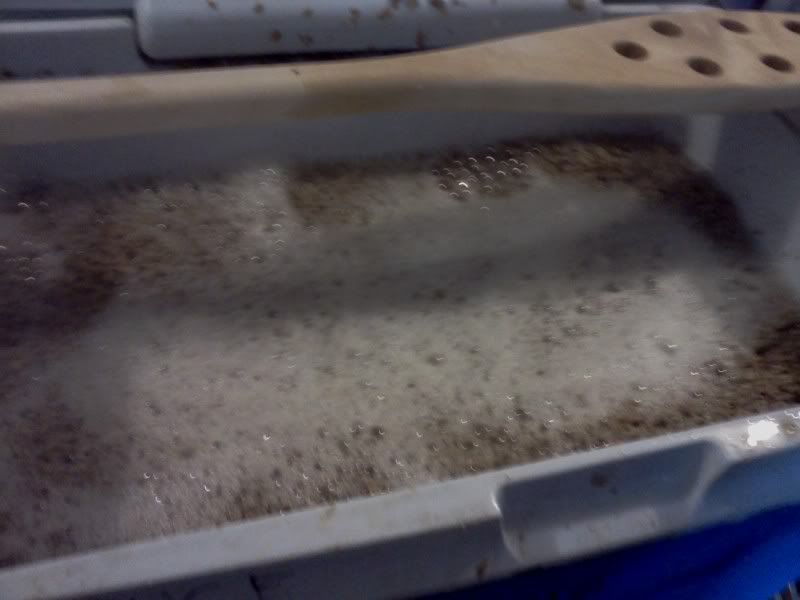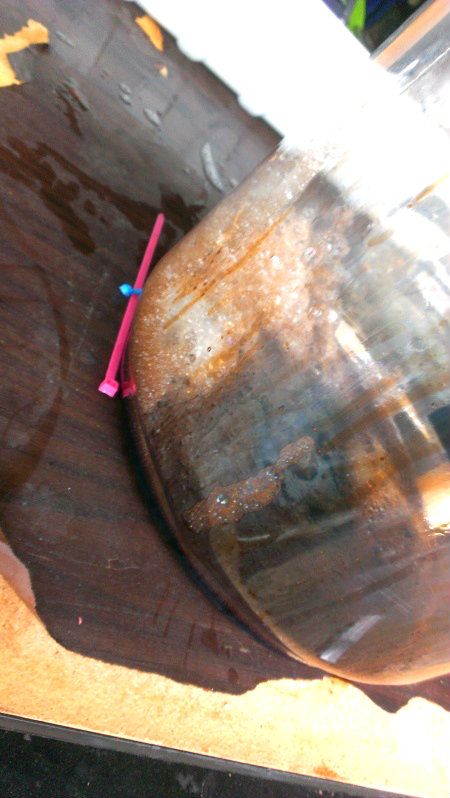 I learned early on that I needed to find a way to brew more beer without taking away more time from my family and ministry. Although this seems impossible, I found a trick that has allowed me to double my output while keeping my brew schedule light. I began doing this in my 5th month of brewing and have used it a lot ever since. Basically, make one beer into 2 (or more). There are a couple options for doing this, some require a little more time and effort, others are no more difficult than making a single 10 gallon batch.
I learned early on that I needed to find a way to brew more beer without taking away more time from my family and ministry. Although this seems impossible, I found a trick that has allowed me to double my output while keeping my brew schedule light. I began doing this in my 5th month of brewing and have used it a lot ever since. Basically, make one beer into 2 (or more). There are a couple options for doing this, some require a little more time and effort, others are no more difficult than making a single 10 gallon batch. Partigyle is a method of mashing a large amount of grain and splitting the runnings off into a larger and smaller beer. The more you sparge, the more diluted the wort sugars become, so if you split the early runnings into one kettle and reserve the later runnings for a seperate boil, you will have a high gravity beer as well as a lower gravity one. This can be used to make a Barley Wine and Pale Ale, a Wee Heavy and 60- or Bitter, an Imperial Stout and Dry Stout or Milk Stout, a Dopplebock and Munich Dunkel, or Belgian Strong and a Table Beer. The list is endless, as you could easily do a Pilsner malt heavy grain bill for a Belgian Strong and ferment the second runnings beer with lager yeast for a Helles or Pilsner. You can also use a method called "capping" where you add extra malts to the mash after you have run off the big beer, to add more character or create a completely different wort. Try making an all Marris Otter English Barleywine, and after running off the BW wort, add a 1/2 pound of crystal malt and roast barley along with 1 pound of chocolate malt to make a stout, or maybe 1 pound crystal and 1/2# chocolate for a brown. You could even add 1/2 pound of Carafa III to that all Pils base mentioned above for a Schwarbier.
Partigyle is a method of mashing a large amount of grain and splitting the runnings off into a larger and smaller beer. The more you sparge, the more diluted the wort sugars become, so if you split the early runnings into one kettle and reserve the later runnings for a seperate boil, you will have a high gravity beer as well as a lower gravity one. This can be used to make a Barley Wine and Pale Ale, a Wee Heavy and 60- or Bitter, an Imperial Stout and Dry Stout or Milk Stout, a Dopplebock and Munich Dunkel, or Belgian Strong and a Table Beer. The list is endless, as you could easily do a Pilsner malt heavy grain bill for a Belgian Strong and ferment the second runnings beer with lager yeast for a Helles or Pilsner. You can also use a method called "capping" where you add extra malts to the mash after you have run off the big beer, to add more character or create a completely different wort. Try making an all Marris Otter English Barleywine, and after running off the BW wort, add a 1/2 pound of crystal malt and roast barley along with 1 pound of chocolate malt to make a stout, or maybe 1 pound crystal and 1/2# chocolate for a brown. You could even add 1/2 pound of Carafa III to that all Pils base mentioned above for a Schwarbier.
This option does require that you do an extended brewday since you will have to do 2 seperate runoffs and boils, and possibly wait for the capping grains to get into the mash (20-30 mins). So far I have done 3 partigyle brews and have not cared for the small beers. They tend to be thin and lacking depth of flavor. This can come from the fact that the bulk of the flavor and color and body, along with the sugars, come out in the earlier runnings. Capping can be used to counteract some of this by adding body and flavor back to the beer, so if you mashed low on temp for conversion, it would be a good idea to add Carapils for added body.
Split Boils can offer another possibility for gaining multiple beers from a single brewday. Instead of running the single mash off into 2 boils with different OGs from separate runnings like above, the entire pre-boil volume for the 2 beers is run off together. The first time I did this I ran the 13 gallons of wort into a 15 gallon rubbermaid container, now I just run it into my 15.5 gallon keggle. Once you have the entire runnings together, you split them into 2 separate but equal batches. At this point you can do widely varied beers. I have done this a lot with my wheat beers.
I did a Hefeweisse and Wheat IPA with Pineapple; one got light hopping with Sterlings and a Hefe yeast open fermented, the IPA got heavy doses of Falconer's Flight and a pineapple in secondary with 1056. I also did a Wit and Gumballhead Clone from the same mash. All Wheat and Pale Malt on the mash, split, Oats in the boil of the Wit as well as orange peel, coriander, and Belgian yeast, and Caravienne steeped on the Gumballhead with lots of Amarillo. As the above examples show this method can be used to make different beers from the same mash of the same (or similar) gravities by using different hops, adding steeping grains, and changing yeasts. You can use this method to make two IPAs with different hops, or to compare two different hops in a single hopped pale ale. You can make a Bitter and Dry Stout by mashing Pale Malt and Crystal Malt and steeping Roast Barley in one half of the runnings before the boil. You can also add sugar to one batch during the boil to change the OG and fermentability of one half as well as the other aspects like hops, spicing, color, and/or flavor.
I did a Hefeweisse and Wheat IPA with Pineapple; one got light hopping with Sterlings and a Hefe yeast open fermented, the IPA got heavy doses of Falconer's Flight and a pineapple in secondary with 1056. I also did a Wit and Gumballhead Clone from the same mash. All Wheat and Pale Malt on the mash, split, Oats in the boil of the Wit as well as orange peel, coriander, and Belgian yeast, and Caravienne steeped on the Gumballhead with lots of Amarillo. As the above examples show this method can be used to make different beers from the same mash of the same (or similar) gravities by using different hops, adding steeping grains, and changing yeasts. You can use this method to make two IPAs with different hops, or to compare two different hops in a single hopped pale ale. You can make a Bitter and Dry Stout by mashing Pale Malt and Crystal Malt and steeping Roast Barley in one half of the runnings before the boil. You can also add sugar to one batch during the boil to change the OG and fermentability of one half as well as the other aspects like hops, spicing, color, and/or flavor.
Split Primary or Secondary Fermentations can also be used. In this method you run off one single large batch of wort, a full volume of pre-boil wort for 2 batches, just as with the split boils, but in this case you keep it all together. This method requires the ability to do a large combined boil (though you could do a 5 gallon batch and split it to 2 separate 2.5 gallon fermentations). Once wort is collected you add all your hops and spices and such and boil it as one batch. After the boil and chilling you send the beers to separate fermenters. From here you can add the same exact yeast strains and ferment at different temps, or ferment the same and add different spices or addatives after fermentation is done. You can age some on oak and leave the remainder plain. You can use different yeasts for comparison as I did with West Yorkshire and London ESB, or an English strain verses American in an IPA. You can make a Pilsner wort and ferment one half on a lager yeast and the other on Belgian Saison as I did.

Adding character malts to the beer in the fermenter is another option, as I did by cold steeping Midnight Wheat over night and adding the (boiled and chilled) syrup to one of the fermenters. I fermented these two IPAs on seperate yeasts, and used different dry hops (another option to switch it up in the fermenter/secondary). Another option is to ferment some wort clean and sour the other. I worked up a recipe to brew a Munich Dunkel on Munich Lager and an Oud Bruin/Flander's Brown with a mix of Lacto and Brett L (slurry from brewery). You can also use sugar to change the OG and FG (and ABV) of one batch or add two different sugars to the split batches to compare the flavor contributions. I have a recipe written up for Belgian Dark Strong and Flander's Red split batch that will do a single mash at 158*F, and single boil, then add a hefty dose of flavorful sugar to one batch fermented with Belgian yeast @ 72*F, and the second fermenter will get oak and wild yeast alongside Belgian yeast to ferment for 12 months.
The possibilities are endless when you begin to think outside the standard single 5 gallon batch frame work. Big and small beers from one mash in two boils, 2 equal gravity beers from a single mash and separate boils, or 2 beers from one mash and one boil. Different hops, different yeasts, different character malts, different temperatures, different spices, different sugars, different aging regimes, what ever you can think of, the sky is the limit. And the great thing about it is that you can brew multiple beers in the same amount of time or a few hours more than it takes to brew 5 gallons. From here you can go even farther. 20 gallons of wort: partigyle 5 for a big beer, 10 gallons of same boil split ferment, and 5 gallons of small beer. 15 gallons of beer, 10 gallons split boil and 5 gallons of small beer (I did this with my Hefe and Wheat IPA when I took the last runnings and sour mashed them then fermented it wild for a session sour). You can even change it all upon bottling by adding Brett to one batch and leaving the rest clean, spiking with fruit extract, or adding additional priming sugar to one batch to see how carbonation levels effect hop aroma, mouthfeel, and finish.
Dare to dream. Dare to brew. Dare to have a life outside of dreaming about brewing.
***This posting was eventually expanded into a full article in Brew Your Own magazine, October, 2014***
Dare to dream. Dare to brew. Dare to have a life outside of dreaming about brewing.
***This posting was eventually expanded into a full article in Brew Your Own magazine, October, 2014***




No comments:
Post a Comment